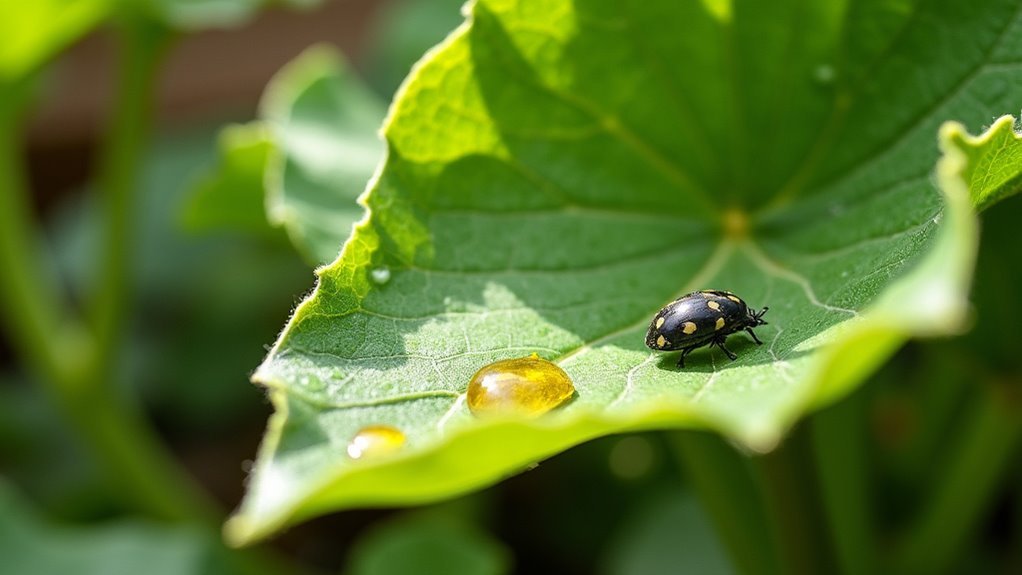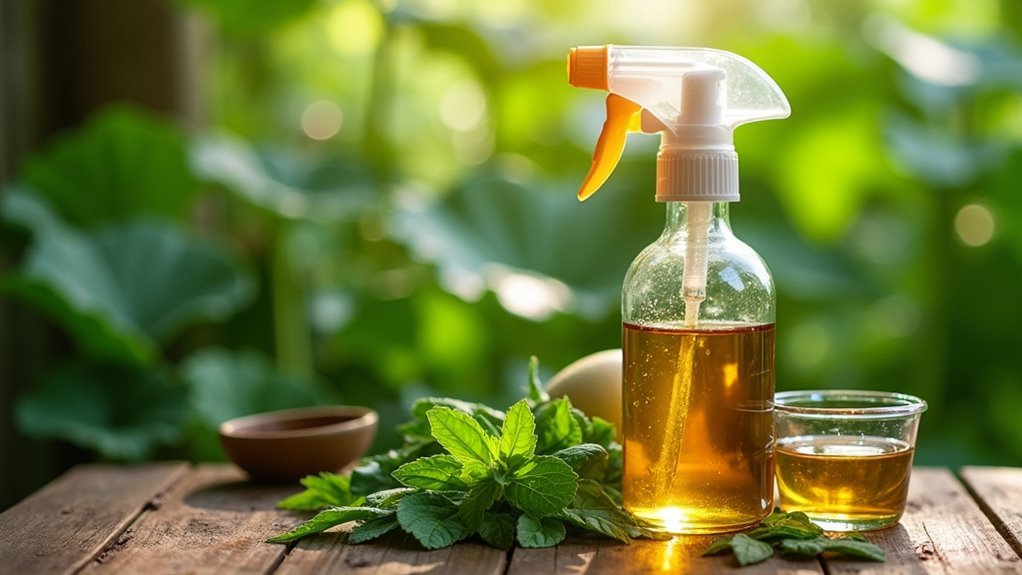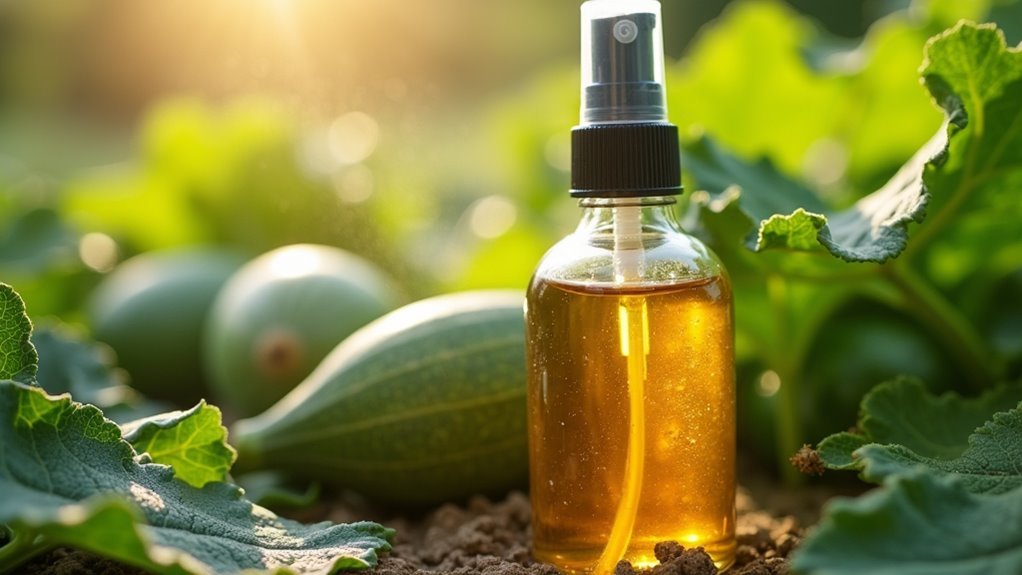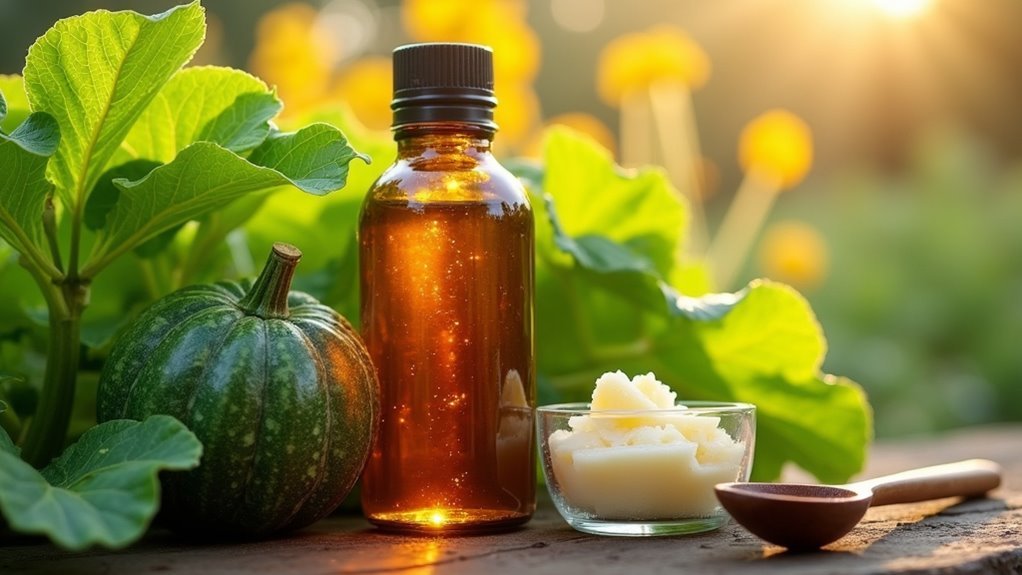You can eliminate squash bugs by mixing 2 tablespoons of pure neem oil with 1 gallon of water and 2 teaspoons of gentle dish soap as an emulsifier. Apply this homemade spray during early morning or evening, focusing on leaf undersides where bugs hide. The neem oil disrupts their molting process and targets vulnerable nymphs most effectively. Reapply every 3-4 days for active infestations, shaking well before each use. Below you’ll discover advanced application techniques and monitoring strategies.
What Is Neem Oil and How Does It Work Against Squash Bugs

When you’re dealing with persistent squash bugs damaging your garden, neem oil offers a natural solution that works as both an insecticide and repellent to stop these pests from feeding on your plants.
This natural pesticide comes from neem tree seeds and contains azadirachtin, the active compound responsible for its effectiveness. Unlike synthetic chemicals, neem oil disrupts squash bugs’ molting process, targeting their growth and reproduction cycles.
It’s particularly effective against nymphs, which are more vulnerable than adult bugs. The oil loses its potency after drying, so proper application timing matters.
You’ll need consistent use since results aren’t immediate—expect to wait two days or more to see noticeable population reduction in your garden.
Why Make Homemade Neem Oil Spray Instead of Store-Bought
While store-bought neem oil sprays might seem convenient, you’ll get better results by making your own homemade version. Most commercial products contain less than 3% azadirachtin, the active ingredient that makes neem oil spray effective against squash bugs.
When you create DIY neem oil spray, you’ll guarantee higher concentrations for superior pest control. Making homemade spray is cost-effective compared to repeatedly buying store-bought pesticides. You’ll save money long-term while achieving better results.
Additionally, you can customize recipes for your garden’s specific pest challenges. Fresh preparation matters too. You’ll mix small batches that get used within 8 hours, maximizing effectiveness against squash bugs.
Store-bought versions can’t promise this freshness level, making homemade the superior choice.
DIY Neem Oil Spray Recipe for Squash Bug Control

You’ll need just three simple ingredients to create an effective neem oil spray that targets squash bugs at every stage of their life cycle. The basic recipe requires proper mixing techniques to guarantee the oil emulsifies correctly with water, while timing your application makes all the difference in effectiveness. Let’s break down the exact measurements and essential tips that’ll help you mix and apply this natural pesticide for maximum squash bug control.
Basic Neem Oil Recipe
Creating an effective neem oil spray for squash bug control requires just three simple ingredients you likely have at home.
Mix 2 tablespoons of 100% pure neem oil with 1 gallon of water and 2 teaspoons of gentle dish soap in a mister. This recipe creates a potent solution that targets squash bugs while remaining safe for your plants.
You’ll need to apply the spray immediately after mixing since neem oil degrades quickly in water. The mixture loses its effectiveness within 8 hours, so don’t prepare large batches ahead of time.
The dish soap acts as an emulsifier, helping the oil blend properly with water for even distribution. Use a fine misting spray to guarantee complete coverage on all plant surfaces where squash bugs congregate.
Application and Mixing Tips
Proper mixing technique makes the difference between an effective spray and wasted effort. You’ll need to shake your neem oil mixture vigorously before each application to guarantee even distribution throughout the spray. Without proper mixing, the oil separates and won’t effectively target squash bugs.
Apply your neem oil spray during early morning or late evening hours when direct sunlight won’t degrade its effectiveness. This timing protects the oil’s potency and maximizes your results against squash bugs.
| Application Factor | Recommendation |
|---|---|
| Best Timing | Early morning/late evening |
| Shake Duration | 30-60 seconds before use |
| Usage Window | Within 8 hours of mixing |
| Reapplication Schedule | Every 3-4 days |
| Weather Conditions | Avoid windy or rainy days |
Remember to mix fresh batches regularly for peak pest control effectiveness.
Essential Application Techniques for Maximum Effectiveness
You’ve mixed your neem oil spray, but applying it correctly makes the difference between success and failure in controlling squash bugs.
Getting the right concentration, timing your applications strategically, and ensuring complete plant coverage aren’t just recommendations—they’re essential steps that determine whether pests survive or disappear.
Master these three application techniques, and you’ll transform your homemade spray into a powerful weapon against garden invaders.
Proper Mixing Ratios
Getting the right neem oil concentration makes all the difference between effective pest control and wasted effort. For your homemade neem oil spray targeting squash bugs, you’ll need a precise mixture of one gallon of water combined with 1/4 cup of 100% pure neem oil.
Don’t forget to add one teaspoon of dish soap – this vital ingredient helps emulsify the oil, guaranteeing it blends properly with water instead of separating.
Always shake your mixture thoroughly before each application. This step guarantees even distribution of neem oil throughout the spray, maximizing its effectiveness against squash bugs.
Remember to apply your freshly mixed solution immediately, as neem oil degrades rapidly in water and works best when used within eight hours of preparation.
Optimal Spray Timing
Timing your neem oil applications strategically determines whether you’ll achieve successful squash bug control or watch your efforts fall short.
Apply neem oil spray during early morning or late evening hours to maximize effectiveness while protecting your plants from potential sun damage. Direct sunlight reduces neem oil’s potency and can harm treated foliage.
For severe squash bug infestations, maintain consistent timing by respraying every three days. This frequent application guarantees continuous coverage and prevents pest populations from recovering between treatments.
Monitor your plants regularly and apply neem oil immediately upon detecting squash bugs. Quick timing enhances control measures considerably.
Remember that fresh neem oil spray works best—mix small batches and use within eight hours for ideal potency during each strategic application.
Thorough Coverage Methods
Three critical application principles separate effective neem oil treatments from wasteful attempts that leave squash bugs thriving on your plants.
First, you’ll want to apply neem oil as a fine mist rather than thick droplets. This technique guarantees superior coverage across leaf surfaces while preventing wasteful runoff that reduces effectiveness against pests.
Second, shake your sprayer thoroughly before each application. This distributes the neem oil mixture evenly, maximizing its pest-fighting potential on your plants.
- Apply fine mist coverage to prevent runoff and improve surface contact
- Shake sprayer well before use to distribute neem oil evenly
- Test spray on small plant areas first to check tolerance
- Target both leaf tops and undersides where pests hide
- Maintain consistent coverage patterns to eliminate missed spots
How Often to Apply Neem Oil Spray on Squash Plants
How frequently should you apply neem oil spray to keep your squash plants healthy and pest-free? Your application schedule depends on whether you’re dealing with an active infestation or preventing future problems.
For acute squash bug infestations, apply neem oil spray at least twice weekly to effectively control the pest population. After initial applications, reapply every three to four days until you’ve completely eliminated target pests on your squash plants.
For prevention, maintain a routine spray schedule every 7-14 days to deter pests and keep plants healthy.
Remember that neem oil takes two days or more to show noticeable results, so consistency is essential for long-term control. Always use freshly mixed neem oil spray within 8 hours for maximum effectiveness.
Best Practices for Misting and Coverage

When applying neem oil spray to your squash plants, proper misting technique makes the difference between effective pest control and wasted effort.
You’ll want to use a fine mist from your spray bottle to guarantee complete coverage on all leaf surfaces. Light misting creates better adhesion than heavy soaking while reducing drying time.
Follow these essential misting practices:
- Shake well before each use to properly mix the neem oil solution
- Apply during early morning or evening when temperatures are cooler
- Test spray on a single leaf first, especially with stressed plants
- Use fine mist settings for superior coverage compared to thick sprays
- Allow 45 minutes for light applications to dry completely
Proper timing prevents rapid evaporation and enhances plant absorption for maximum effectiveness.
Monitoring and Identifying Squash Bug Infestations
Why wait until squash bugs have devastated your plants when early detection can save your entire harvest?
Effective monitoring starts with weekly inspections of your squash plants, focusing on the undersides of leaves where bronze-colored adults deposit their distinctive egg clusters. You’ll spot these eggs as copper-colored, oval-shaped masses that signal infesting populations before they explode.
Check leaf undersides weekly for copper-colored egg clusters before squash bug populations explode into devastating infestations.
Watch for wilting or yellowing leaves, which indicate squash bugs are already feeding on plant juices. Check around garden debris and protected areas where these pests overwinter.
Document your findings in a garden journal, noting dates and locations of activity.
When you discover early signs of infestation, immediately apply neem oil spray to affected areas. This proactive approach prevents minor problems from becoming major crop losses.
Additional Organic Methods to Enhance Neem Oil Treatment
While neem oil provides excellent standalone protection against squash bugs, combining it with complementary organic methods creates a multi-layered defense that’s far more effective than any single treatment.
You can greatly boost your neem oil’s pest-fighting power by incorporating these organic enhancements:
- Mix with kaolin clay – Creates a physical barrier that blocks pests while neem oil disrupts their reproduction.
- Add garlic juice concentrate – Natural insect deterrent that amplifies the spray’s repelling properties.
- Include organic soap – Helps solution adhere better to plant surfaces for improved pest control.
- Combine with hand-picking – Physical removal complements neem oil’s chemical action for maximum population reduction.
- Apply during early morning hours – Prevents sunlight degradation while maintaining treatment effectiveness.
Frequently Asked Questions
What Is the Ratio of Neem Oil to Water for Spray?
You’ll need 2 tablespoons of neem oil per gallon of water for your spray. For smaller batches, use 1 tablespoon per half-gallon or 1.5 teaspoons per quart of water.
How Do You Make Homemade Squash Bug Killer?
You’ll mix one gallon of water with 1/4 cup neem oil, 1/4 cup molasses, and one teaspoon dish soap in a spray container for effective homemade squash bug elimination.
How Do I Permanently Get Rid of Squash Bugs?
You can’t permanently eliminate squash bugs, but you’ll minimize them by planting resistant varieties, using companion plants like marigolds, maintaining healthy soil, consistently monitoring, hand-picking daily, and applying preventative neem oil sprays.
What Is the Best Spray to Kill Squash Bugs?
You’ll find neem oil spray is the best option for killing squash bugs. Mix one gallon water, quarter cup neem oil, and one teaspoon dish soap for effective results.
In Summary
You’ve now got a powerful, natural weapon against squash bugs with this homemade neem oil spray. Remember to apply it consistently during early morning or evening hours, and don’t forget to coat the undersides of leaves where bugs hide. Monitor your plants regularly, and combine this treatment with companion planting and physical removal for best results. Your squash plants will thrive pest-free with this organic approach.





Leave a Reply